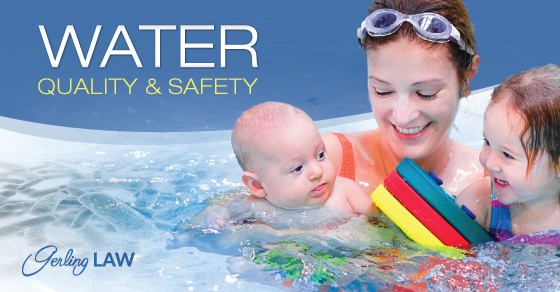It’s bad enough to be sick in the winter when the weather is uncooperative, but to be ill in the summertime when you really want to be out enjoying the sunshine seems especially unfair. Yes, illness can strike at any time, and sometimes its source is the thing you least expect.

After a day of fun out by the pool, enjoying the sunshine and eating delicious (and maybe not-so-healthy) poolside snacks, you might find yourself with a version of what is usually called “stomach flu” – although it’s not the flu. The fever, nausea, and intestinal distress many times is attributed to food poisoning (from that lukewarm hotdog you ate, maybe?) but it may very likely be a Recreational Water Illness (RWI).
What are Recreational Water Illnesses?
If you fall ill a day or two after an outing to the pool or water park, it might be because you’ve picked up a bacteria or parasite from the water. While you might expect ocean, lake, or river water to harbor some unsavory organisms, that cool, crystal clear water at the local public pool could be concealing some nasties that are just as bad.
The illnesses that sometimes spring up around water fun are the result of contact with water contaminated by bacteria or parasites, which can cause infection in the eyes or ears or upset your intestinal tract. You can contract these RWIs by ingesting contaminated water or exposing an open wound to water containing these organisms.
Most people with healthy immune systems recover from such an illness within a week or two, but if you have a compromised immune system the complications can be serious.
Water Quality in Public Pools
Don’t let clear blue water in a pool or water park fool you!
The CDC recently released a report on the water quality at public facilities across the nation, and the results are unsettling. An astounding 80% of all public aquatic venues nationwide tested positive for dirty water. Top contaminants on the list were E. coli, cryptosporidium, norovirus, and Shigella. And what’s worse, the usual chemical treatments don’t kill many of these bacteria and organisms.
If the water quality of a pool is bad enough to warrant a closure, it will take extensive work by facility managers to treat the water and filtration system.
How to Protect Yourself
“Shower before entering the water” – it seems like a funny rule to have at a pool, where you’re going to get wet anyway, but this precaution is designed to limit contamination of the water. Because some organisms are resistant to chemical treatments – Cryptosporidium can live in chlorinated water for several days – the best defense against dirty pool water is to keep germs out in the first place.
The majority of organisms found in public pool facilities are present on the skin, either from children still learning toileting skills or from others recovering from a bout of intestinal distress, and showering helps to rinse them from skin.
Other precautions to take:
- pH test strips – You can purchase these at any pool store, and a quick dip in the water will tell you what the pH levels are; the proper pH for pool chemicals to do their job is 7.4-7.6.
- Do not swallow water – This might seem like an obvious precaution, but many illnesses begin by ingesting just a small amount of contaminated water
- No open wounds – If you’ve got an open wound or stitches but the skin has not healed, germs can enter this wound and produce an infection
- Bathroom breaks – Take children out of the pool for a bathroom break at least once an hour
- Wash your hands – Always wash your hands after a bathroom break, and supervise young children in washing their hands
- Diaper changes – Regular diapers and swim diapers should be changed in the facility restroom, not poolside
- Stay home – If you’ve got an intestinal illness or have recently recovered from one, stay away from the pool for a week or two
- Observe staffing – Pool managers and lifeguards are often tasked with checking water quality throughout the day; be aware of how often water is tested while you are onsite.
Safety in the water isn’t only about water quality, however. Even if you frequent a pool or water park that’s consistently contaminant-free, you still need to be concerned about your safety in the water. The best way to assure that is to learn to swim.
Nearly half of American adults cannot pass a basic swimming test, although most will say they know how to swim. If it’s been a while since you’ve put your swimming skills to the test, you might want to check into a refresher – many local pools and organizations such as the YMCA offer swimming lessons.
We’ve got a long, hot summer ahead of us here in the Tri-State area, and that means a lot of water fun. Don’t let your day at the pool or water park turn into something that’s not-so-fun – learn how to protect yourself and your loved ones from illness and injury in the water!
